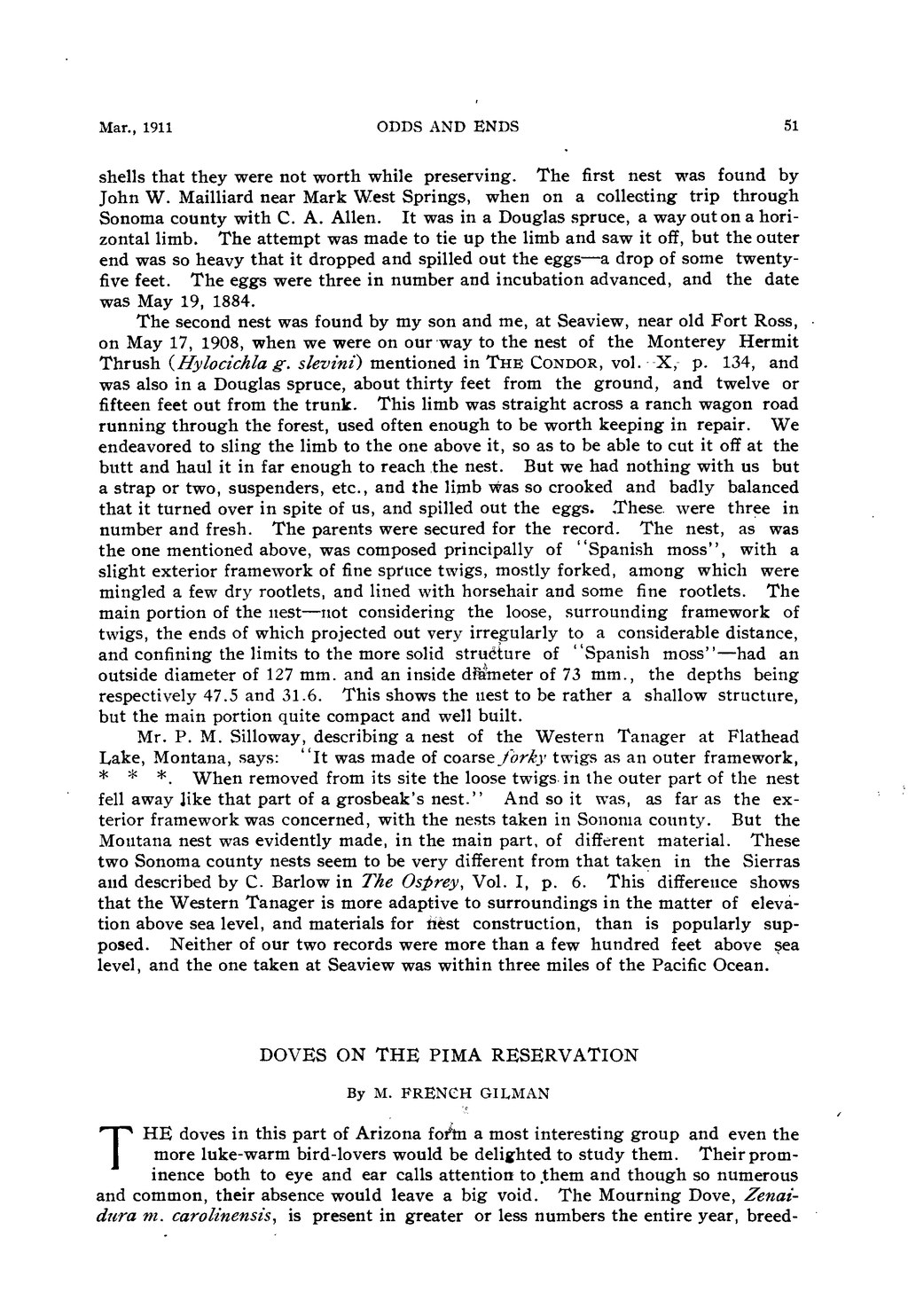Mar., 1911 ODDS AND ENDS 51 shells that they were not worth while preserving. The first nest was found by John W. Mailliard near Mark West Springs, when on a collecting trip through Sonoma county with C. A. Alien. It was in a Douglas spruce, a way out on a hori- zontal limb. The attempt was made to tie up the limb and saw it off, but the outer end was so heavy that it dropped and spilled out the eggs--a drop of some twenty- five feet. The eggs were three in number and incubation advanced, and the date was May 19, 1884. The second nest was found by my son and me, at Seaview, near old Fort Ross, on May 17, 1908, when we were on our way to the nest of the Monterey Hermit Thrush (Hylocichla g. slevini) mentioned in THE CONDOR, vol.- X, p. 134, and was also in a Douglas spruce, about thirty feet from the ground, and twelve or fifteen feet out from the trunk. This limb was straight across a ranch wagon road running through the forest, used often enough to be worth keeping in repair. We endeavored to sling the limb to the one above it, so as to be able to cut it off at the butt and haul it in far enough to reach .the nest. But we had nothing with us but a strap or two, suspenders, etc., and the limb Was so crooked and badly balanced that it turned over in spite of us, and spilled out the eggs. .These. ?vere three in number and fresh. The parents were secured for the record. The nest, as was the one mentioned above, was composed principally of "Spanish moss", with a slight exterior framework of fine spruce twigs, mostly forked, among which were mingled a few dry rootlets, and lined with horsehair and some fine rootlets. The main portion of the nest--not considering the loose, surrounding framework of twigs, the ends of which projected out very irregularly to a considerable distance, and confining the limits to the more solid strue[ure of "Spanish moss"--had an outside diameter of 127 min. and an inside diameter of 73 ram., the depths being respectively 47.5 and 31.6. This shows the nest to be rather a shallow structure, but the main portion quite compact and well built. Mr. P.M. Silloway, describing a nest of the Western Tanager at Flathead Lake, Montana, says: "It was made of coarsefOrky twigs as an outer framework,
- * * When removed from its site the loose twigs. in the outer part of the nest
fell away like that part of a grosbeak's nest." And so it was, as far as the ex- terior framework was concerned, with the nests taken in Sonoma county. But the Montana nest was evidently made, in the main part, of different material. These two Sonoma county nests seem to be very different from that taken in the Sierras and described by C. Barlow in The Osprey, Vol. I, p. 6. This difference shows that the Western Tanager is more adaptive to surroundings in the matter of eleva- tion above sea level, and materials for nest construction, than is popularly sup- posed. Neither of our two records were more than a few hundred feet above s?ea level, and the one taken at Seaview was within three miles of the Pacific Ocean. DOVES ON THE PIMA RESERVATION By M. FRENCH GILMAN HE doves in this part of Arizona fohn a most interesting group and even the more luke-warm bird-lovers would be delighted to study them. Their prom- inence both to eye and ear calls attention to .them and though so numerous and common, their absence would leave a big void. The Mourning Dove, Zenai- dura m. carolinensis, is present in greater or less numbers the entire year, breed-
